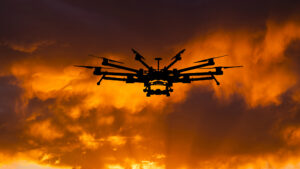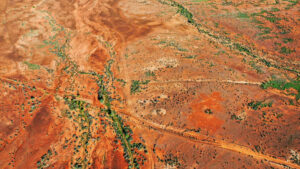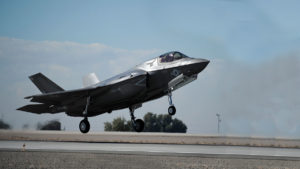Quickstep embraces growing demand for aerospace composite manufacturing at home and abroad

Pic: Getty Images
From drones and missiles to commercial and military aircraft, Quickstep Holdings is making a name for itself globally as a leader in aerospace composite manufacturing.
Australia’s largest independent aerospace composite manufacturer Quickstep Holdings (ASX:QHL) has been on an evolutionary path during the past decade.
QHL listed on the ASX in 2005 as a tech company with process technology. However, CEO and managing director Mark Burgess said it has evolved over the past decade into an engineering and manufacturing business in the aerospace and defence segments.
With three distinct lines of business including aerostructures, aftermarket and applied composites, three Australian locations and one in the US, the business employs 300 people and delivers almost $100 million in revenue.
“Aerostructures is all about defence and aerospace components and assemblies for military aircraft including F-35s, C-130s and a range of Boeing fighter jets,” Burgess said.
“We have an after-market business we acquired from Boeing a couple of years ago which services the airline and charters markets so again composite parts and repairing large components on commercial aircraft like 737s, A-320s and 787s.
“We do things like the housing that goes around the engine (called a nacelle), radomes, rudders, wing flaps, door hatches, so large structures you don’t want to be flying around the world – avoiding unnecessary emissions is a huge thing for the airlines”
The third aspect of QHL’s business, providing applied composites, has historically done a lot of work with automotive, medical devices and other transportation sectors.
However, Burgess said QHL is now focusing that area of the business on sophisticated, commercial drones from the smaller weight classes of 25 to 50kg up to much larger, heavier classes.
“We are just about to commence building one with a 16m wingspan that can carry 350kg more than 2000km,” he said.
“The drones area of our business is a real focus because that market is starting to really explode worldwide.”
The company has taken an equity stake in Aussie drone businesses Carbonix and Swoop Aero to get structural exposure to the sector.
“We have contracts with Sprite, a large drone business in the US, and with Dronamics, a European drone company, so we are winning some notable contracts in that space,” he said.
He said essentially QHL’s core competencies are aerospace, particularly in the defence realm, engineering and manufacturing process technologies, product development, build and sustainment of those products in service.
“We have a real theme of carbon composites expertise running through our business,” he said.
QHL’s customer base includes big names such as Lockheed Martin, Boeing, Northrop Grumman, BAE Systems, Qantas, Jetstar, Virgin Australia and Alliance Airlines.
Winning business in northern hemisphere
Burgess said currently 90% of QHL’s products are exported and its market is predominately the northern hemisphere.
“The flip side of the tyranny of distance is incredible creativity and ingenuity within the engineering base here,” he said.
“We can typically do things much faster and much cheaper and at a comparable or better standard of quality than most of our competitors in the northern hemisphere.”
Beyond beaches and kangaroos
He said when most people think of Australia from overseas – and even locally – manufacturing is not an industry which comes to mind.
“When people think of Australia they think of beaches and kangaroos and they don’t think of manufacturing and that applies to Australians too, unfortunately,” he said.
“But we are good at what we do and typically the best supplier on the programs we are involved in, both in the US and UK.”
Burgess said QHL also makes good profit margins from its core Aerostructures business compared to other northern hemisphere businesses in the sector.
“The core challenge we’ve got is the market isn’t here and no one builds planes in Australia,” he said.
“There are no OEMs (original equipment manufacturers), so everything is offshore and Australia is not known as a manufacturing powerhouse.”
Burgess said the company as such moved on diversification in the past few years.
“That’s hard with a business like ours, where the core is a profitable but modest margin manufacturing business, to then set up two new businesses simultaneously,” he said.
He said it is particularly difficult under the spotlight of being a listed company.
“Most of the oxygen in this country is consumed by resources and there might be a bit of space for other things but certainly not industrials,” Burgess said.
“The default is not confidence but lack of confidence.
“We have some great IP and proprietary process technology, but the fundamental strength of our business is we are better than most we compete with on a world stage.”
Burgess said there are some genuine pockets of excellence in the manufacturing sector in Australia.
“Most people think manufacturing doesn’t exist in Australia anymore,” he said.
“But what they fail to grasp is the future of manufacturing is advanced manufacturing, not a large assembly line with 2500 people.
“It’s a factory which costs $150 million to build and employs 25 people because we can’t compete from a labour standpoint, so everything we do has to drive labour content down to the lowest logical level and individual skills up.”
2022 – the year Australia caught Covid
Burgess said 2022 was the year Australia caught Covid with supply chain issues and high amounts of absenteeism putting pressure on the QHL workforce.
“Our revenue has continued to grow but our profit metrics were under strain because the core business was not performing well because of Covid-19 impacts,” he said.
“We were also still trying to build out two new businesses.”
Burgess said QHL went into Covid with a market cap of ~$130 million and 55% institutional investors on the register.
“Once we plummeted below $100 million in March 2020 half of them left because that was their floor and then when we went below $50 million the other half left because that was their floor” he said.
“Nothing in our business had changed apart from revenue and profit growth but as a small cap in a heavily exposed industry segment Covid gutted our share price and the register.”
He said the company is now in recovery mode in the core business and building out the two new businesses.
“Australia has a thriving aviation market, and all the airlines want capability back onshore and we have a unique facility down in Melbourne and can do that work here,” he said.
“The Australian market for components is about US$400 million annually and over the last 30 years most of that has gone offshore but what we are seeing now is a reverse of that by the airlines.”
“There is no comparison on the index and no one like us in Australia who are listed and there’s no analysis on the sector.”
He said there is a gap in understanding the sector with huge growth prospects in some of the most exciting segments in aerospace.
“You may not have heard of us, but you have definitely heard of our customers,” he said.
Defence Strategic Review tailwinds
Burgess said the company is also well positioned to benefit from the Defence Strategic Review, to improve Australia’s defence capabilities.
“Most missile structures are made out of composite, and the western world is facing capacity shortages in the wake of the Russian invasion of Ukraine, so we feel really well positioned for missile business,” he said.
“Over the next few years there will be significant opportunities to build airframes for missiles and components for the launch systems as well, which is potentially huge.”
This article was developed in collaboration with Quickstep Holdings, a Stockhead advertiser at the time of publishing.
This article does not constitute financial product advice. You should consider obtaining independent advice before making any financial decisions.
Related Topics
UNLOCK INSIGHTS
Discover the untold stories of emerging ASX stocks.
Daily news and expert analysis, it's free to subscribe.
By proceeding, you confirm you understand that we handle personal information in accordance with our Privacy Policy.








